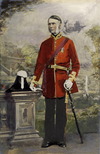ROSS, SALLY (Sarah), Okanagan Indian and housewife; b. c. 1798 in the Columbia River area, daughter of an Okanagan Indian chief; m. c. 1812 presumably by Indian rites to Alexander Ross*, and on 24 Dec. 1828 she was baptized and married to Ross “by Banns with mutual consent” in the Anglican Upper Church (later St John’s Church), Red River Settlement (Man.); they had at least 12 children; d. 26 Feb. 1884 in Winnipeg, Man.
Sally Ross was born into a peaceful tribe of Okanagan hunters and fishermen. Her simple life within the tribe was profoundly affected by the impact of three fur-trading companies upon the area. Sally probably met her future husband, Alexander Ross, soon after his arrival in the Columbia region as a clerk with the Pacific Fur Company at Fort Okanagan (Wash.) in 1811. Two years later that company was bought out by the North West Company, which, in turn, amalgamated with the Hudson’s Bay Company in 1821. Ross worked for each of these firms in succession until 1825 when, as one of several “expensive clerks with large families,” he was transferred by Governor George Simpson* to Red River. Ross set off with his eldest son, leaving Sally to follow with the other four children. She left Spokane House (near Spokane, Wash.) with the HBC express on 19 Sept. 1825 and ascended the Columbia River via Boat Encampment (B.C.) to Jasper House (Alta) where she wintered with her children. In May she left with the brigade going east, riding where practicable with one child secured behind her, another on the front on her saddle, and the two others on a second horse. She reached the Red River Settlement in the summer of 1826, the year of a disastrous flood, and with the four children spent the winter at Pembina (N. Dak.) where Alexander had business interests. The following year she proceeded to the Red River Settlement where she was to live for the next 57 years.
Alexander was, in turn, a merchant, a substantial farmer, and, by 1836, a councillor and the sheriff of Assiniboia. The Ross home on the Red River, Colony Gardens, a white, roughcast, two-storey stone building, was noted for its hospitality; “constantly thronged by visitors,” it was a landmark in the settlement. According to Robert Clouston, who visited the settlement in 1843, Sally seldom appeared in public except in church, but she was a central figure in her large bustling household, and in her later years was known to the whole Red River community as “Granny Ross.”
In his great “wilderness trilogy” of histories of the west, published between 1849 and 1856, Alexander Ross stressed the dependence of the fur-trader upon his Indian wife, the “tenderness existing between them,” the protection afforded by her “vigilance,” and the charm which “her smiles” added to his existence. He wrote more personally of his own grief and anxiety when he was forced to leave his family for Red River in 1825. Illiterate herself, Sally may well have contributed much of the detailed information on Indian tribal life which was included in his first two books. When Alexander died in October 1856, he left the substantial portion of his estate to his wife and commended the younger children to her care. Although Sally was “destitute in the accomplishments of etiquette,” her affection and her tender-hearted anxiety for all the children’s welfare were unfailing and they remained loyal to their Indian mother. James* became a lawyer, schoolmaster, journalist, and, in 1869–70, an associate of Louis Riel; Henrietta married John Black, the prominent Manitoba Presbyterian minister. Only one of Sally’s children survived her, a daughter Mary who married the Reverend George Flett.
Sally Ross carried much of her Indian culture with her to Red River; there her concern for family relationships harmonized with that of the numerous Scots. Like many other Indian women, only now being studied by historians, Sally was a link between Indian tribal life, the mixed-bloods, and the new white communities of traders. She became a devout Christian, the centre of a lively and intelligent household, and she was one of the women who contributed to the shaping of Manitoba society.
PABC, Add.
© 1982–2024 University of Toronto/Université Laval
Cite This Article
Laurenda Daniells, “ROSS, SALLY,” in Dictionary of Canadian Biography, vol. 11, University of Toronto/Université Laval, 2003–, accessed April 20, 2024, http://www.biographi.ca/en/bio/ross_sally_11E.html.
The citation above shows the format for footnotes and endnotes according to the Chicago manual of style (16th edition). Information to be used in other citation formats:
| Permalink: | http://www.biographi.ca/en/bio/ross_sally_11E.html |
| Author of Article: | Laurenda Daniells |
| Title of Article: | ROSS, SALLY |
| Publication Name: | Dictionary of Canadian Biography, vol. 11 |
| Publisher: | University of Toronto/Université Laval |
| Year of publication: | 1982 |
| Year of revision: | 1982 |
| Access Date: | April 20, 2024 |










